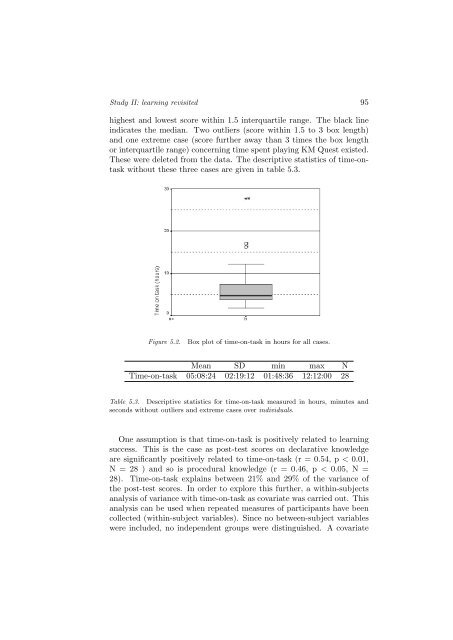The role of metacognitive skills in learning to solve problems
The role of metacognitive skills in learning to solve problems
The role of metacognitive skills in learning to solve problems
Create successful ePaper yourself
Turn your PDF publications into a flip-book with our unique Google optimized e-Paper software.
Study II: learn<strong>in</strong>g revisited 95<br />
highest and lowest score with<strong>in</strong> 1.5 <strong>in</strong>terquartile range. <strong>The</strong> black l<strong>in</strong>e<br />
<strong>in</strong>dicates the median. Two outliers (score with<strong>in</strong> 1.5 <strong>to</strong> 3 box length)<br />
and one extreme case (score further away than 3 times the box length<br />
or <strong>in</strong>terquartile range) concern<strong>in</strong>g time spent play<strong>in</strong>g KM Quest existed.<br />
<strong>The</strong>se were deleted from the data. <strong>The</strong> descriptive statistics <strong>of</strong> time-ontask<br />
without these three cases are given <strong>in</strong> table 5.3.<br />
Figure 5.2.<br />
Box plot <strong>of</strong> time-on-task <strong>in</strong> hours for all cases.<br />
Mean SD m<strong>in</strong> max N<br />
Time-on-task 05:08:24 02:19:12 01:48:36 12:12:00 28<br />
Table 5.3. Descriptive statistics for time-on-task measured <strong>in</strong> hours, m<strong>in</strong>utes and<br />
seconds without outliers and extreme cases over <strong>in</strong>dividuals.<br />
One assumption is that time-on-task is positively related <strong>to</strong> learn<strong>in</strong>g<br />
success. This is the case as post-test scores on declarative knowledge<br />
are significantly positively related <strong>to</strong> time-on-task (r = 0.54, p < 0.01,<br />
N = 28 ) and so is procedural knowledge (r = 0.46, p < 0.05, N =<br />
28). Time-on-task expla<strong>in</strong>s between 21% and 29% <strong>of</strong> the variance <strong>of</strong><br />
the post-test scores. In order <strong>to</strong> explore this further, a with<strong>in</strong>-subjects<br />
analysis <strong>of</strong> variance with time-on-task as covariate was carried out. This<br />
analysis can be used when repeated measures <strong>of</strong> participants have been<br />
collected (with<strong>in</strong>-subject variables). S<strong>in</strong>ce no between-subject variables<br />
were <strong>in</strong>cluded, no <strong>in</strong>dependent groups were dist<strong>in</strong>guished. A covariate
















